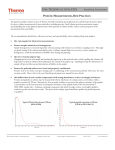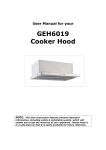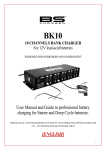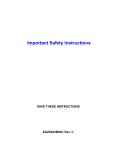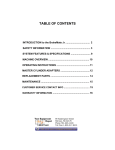Download Safety Information - Snap-on
Transcript
Safety Information For your safety, read this manual thoroughly before operating your scan tool. Your scan tool is intended for use by properly trained, skilled professional automotive technicians. The safety messages presented below and throughout this user’s manual are reminders to the operator to exercise extreme care when using this test instrument. There are many variations in procedures, techniques, tools, and parts for servicing vehicles, as well as in the skill of the individual doing the work. Because of the vast number of test applications and variations in the products that can be tested with this instrument, we cannot possibly anticipate or provide advice or safety messages to cover every situation. It is the automotive technician’s responsibility to be knowledgeable of the system being tested. It is essential to use proper service methods and test procedures and to perform tests in an appropriate and acceptable manner that does not endanger your safety, the safety of others in the work area, or vehicle or equipment being tested. It is assumed the operator has a thorough understanding of vehicle systems before using the scan tool. Understanding of these system principles and operating theories is necessary for competent, safe and accurate use of this instrument. Before using the scan tool, always refer to and follow safety messages and applicable test procedures provided by the manufacturer of the vehicle or equipment being tested. Use equipment only as described in this manual. Read, understand and follow all safety messages and instructions in this manual and on the test equipment. Safety messages in this section of the manual contain a signal word with a three-part message and an icon. The signal word indicates the level of the hazard in a situation. iii Safety Information Safety Message Conventions Safety messages are provided to help prevent personnel injury and equipment damage. All safety messages are introduced by a signal word indicating the hazard level. The types of safety messages are: Indicates an imminently hazardous situation which, if not avoided, will result in death or serious injury to the operator or to bystanders. Indicates a potentially hazardous situation which, if not avoided, could result in death or serious injury to the operator or to bystanders. Indicates a potentially hazardous situation which, if not avoided, may result in moderate or minor injury to the operator or to bystanders. Safety messages contain three different type styles. • Normal type states the hazard. • Bold type states how to avoid the hazard. • Italic type states the possible consequences of not avoiding the hazard. An icon, when present, gives a graphical description of the potential hazard. Important Safety Instructions Risk of personal injury. • Keep yourself, test leads, clothing and other objects clear of electrical connections and hot or moving engine parts. • Do not wear watches, rings, or loose clothing when working in an engine compartment. • Do not place equipment or tools on fenders or other places in the engine compartment. iv Important Safety Instructions • Barriers are recommended to help identify danger zones in test area. Contact with electrical connections and hot or moving parts can cause injury. Risk of entanglement. • Do not allow cable to hang in a manner to become entangled with operator or driving controls. Cable entanglement can cause interference with driving and can cause injury. Risk of electric shock. • Do not attempt to disassemble any battery or remove any component projecting from or protecting the battery terminals. • Remove the Ground lead from the vehicle battery before removing or disassembling any vehicle electrical component. • Disconnect all test leads and turn unit off before removing end grips. • Do not attempt to operate this system without properly installing the end grip. Electric shock can cause injury. Risk of poisoning. • Use this equipment in locations with mechanical ventilation providing at least four air changes per hour. Engine exhaust contains odorless lethal gas. • Route exhaust outside while testing with engine running. Poisoning can result in death or serious injury. Risk of accident. • Two people should be in the vehicle when driving on road, one to drive and the other to attend to the equipment. Accidents can occur when attention is not solely given to driving. v Safety Information Risk of explosion. • Wear safety goggles and protective clothing, (user and bystander). • Use this equipment in locations with ventilation providing at least four air changes per hour. • Flammable fuel and vapors can ignite. • Do not use this system in environments where explosive vapor may collect, such as in below-ground pits, confined areas, or areas that are less than 18 inches (45 cm) above the floor. • Do not smoke, strike a match, place metal tools or objects on the vehicle battery or cause a spark in the vicinity of the battery. Battery gases can ignite. • Avoid making an accidental connection between vehicle battery terminals through tools, jumper leads, etc. • Keep lighted cigarettes, sparks, open flames and other ignition sources away from batteries. • Be sure ignition is off, headlights and other accessories are OFF and vehicle doors are closed before disconnecting vehicle battery cables. This also helps prevent damage to onboard computer systems. • Always disconnect battery ground connections before servicing electrical system components. • Do not expose tester to rain, snow or wet conditions. • Do not allow battery gases or acid to contact tester housing. • Be sure all test leads are connected as instructed before proceeding with a test. • Keep a dry chemical fire extinguisher (Class B) rated for gasoline, chemical and electrical fires in the work area. Explosion can cause death or serious injury. vi Important Safety Instructions Risk of expelling battery acid. • Wear safety goggles and protective gloves, user and bystander. Everyday eyeglasses only have impact resistant lenses, they are NOT safety glasses. • Make sure someone can hear you or is close enough to provide aid when working near a battery. • Have plenty of fresh water and soap nearby. If battery acid contacts skin, clothing, or eyes, flush exposed area with soap and water for 10 minutes. • Seek medical help. • Do not touch eyes while working near battery. Battery acid is a highly corrosive sulfuric acid, can burn eyes and skin. Risk of short circuits and burns. • Batteries can produce a short-circuit current high enough to weld jewelry to metal. Remove jewelry such as rings, bracelets and watches before working near batteries. Short circuits and burns can cause injury. Risk of fire. • Wear safety goggles and protective clothing, user and bystander. • Do not position head directly over or in front of carburetor or throttle body. Do not pour gasoline down carburetor or throttle body when cranking or running engine, when working with fuel delivery systems or any open fuel line. Engine backfire can occur when air cleaner is out of normal position. • Do not use carburetor sprays or fuel injector cleaning solvents when performing diagnostic tests. • Keep cigarettes, sparks, open flame and other sources of ignition away from vehicle. • Keep a dry chemical (Class B) fire extinguisher rated for gasoline, chemical and electrical fires in work area. Fire can cause death or serious injury. vii Safety Information Risk of flying particles. • Wear safety goggles while using electrical equipment. Electrical equipment or rotating engine parts can cause flying particles. Flying particles can cause eye injury. Risk of burns. • Do not remove radiator cap unless engine is cold. Pressurized engine coolant may be hot. • Do not touch hot exhaust systems, manifolds, engines, radiators, sample probe, etc. • Wear gloves when handling hot engine components. • Do not place test equipment or tools on fenders or other places in the engine compartment. Engine compartment contains electrical connections. • Keep yourself, test equipment, clothing and other objects clear of electrical connections. • Tester leads can become hot after extended testing in close proximity to manifolds etc. Wear gloves when handling hot components. • Do not allow test leads to touch exhaust manifolds or other hot parts. Hot components can cause injury. Risk of expelling fuel, oil vapors, hot steam, hot toxic gases, acid, refrigerant and other debris. • Wear safety goggles and protective clothing, user and bystander. Everyday eyeglasses only have impact resistant lenses, they are NOT safety glasses. • Engine systems can malfunction expelling fuel, oil vapors, hot steam, hot toxic exhaust gases, acid, refrigerant and other debris. Fuel, oil vapors, hot steam, hot toxic gases, acid, refrigerant and other debris can cause serious injury. Risk of unexpected vehicle movement. • Block drive wheels before performing a test with engine running. viii Important Safety Instructions • Unless instructed otherwise, set parking brake and put gear selector in neutral or park. • If vehicle has an automatic parking brake release, disconnect release mechanism for testing and reconnect when finished. • Do not leave a running engine unattended. A moving vehicle can cause injury. Risk of incorrect or improper repair and/or adjustment. • Do not rely on erratic, questionable, or obviously erroneous test information or results. If test information or results are erratic, questionable, or obviously erroneous, make sure that all connections and data entry information are correct and that the procedure was performed correctly. • If test information or results are still suspicious, do not use them for diagnosis. Contact Snap-on® customer services. Improper repair and/or adjustment may cause vehicle or equipment damage or unsafe operation. Risk of equipment or circuit damage. • Unless specifically directed by the test procedure, make sure the ignition is off before connecting or disconnecting connectors or any vehicle electrical terminals. • Do not create an electrical connection between battery terminals with a jumper wire or tools. • Do not ground any electrical terminal that has or may have power. Improper equipment use can cause equipment or circuit damage. Save These Instructions ix Safety Information x








